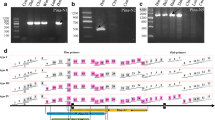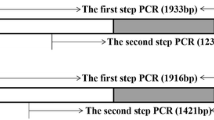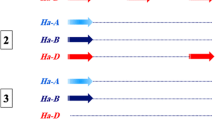Abstract
Grain hardness is a major factor influencing the classification and end-use quality of bread wheat. In this study, 40 Yunnan endemic wheats, 21 historical cultivars and 66 current cultivars and advanced lines were investigated for kernel hardness and puroindoline alleles using molecular and biochemical markers. The frequencies of soft, mixed and hard genotypes were 10.0%, 5.0% and 85.0%, respectively, in Yunnan endemic wheats, whereas the corresponding frequencies were 47.6%, 23.8% and 28.6% in historical cultivars, and 36.3%, 6.1% and 57.6% in current cultivars and advanced lines. Four known puroindoline alleles, Pina-D1b, Pinb-D1b, Pinb-D1d and Pinb-D1e, were found in the hard wheat cultivars. Compared with endemic wheats and historical cultivars, current cultivars from Yunnan province have relatively high frequencies of Pina-D1b and Pinb-D1b alleles at 43.5% and 16.1%, respectively. All 32 hard Yunnan endemic wheats (Triticum aestivum ssp. yunnanense King) contained a new puroindoline b allele, designated Pinb-D1u, that was characterized as a single nucleotide (G) deletion at position 127 in the coding sequence of the Pinb gene, leading to a shift of the open reading frame (ORF) from position 14 in the deduced amino acid sequence and a stop codon corresponding to position Leu-18. The average SKCS hardness of genotypes with Pina-D1b (68.2) is significantly higher than those of Pinb-D1b (60.3) and Pinb-D1u (60.5). The study of puroindoline alleles in Yunnan germplasm could provide useful information for improving processing quality and further understanding the molecular basis of kernel hardness in bread wheat.
Similar content being viewed by others
References
Cane K, Spackman M, Eagles HA (2004) Puroindoline genes and their effects on grains quality traits in southern Australian wheat cultivars. Aust J Agric Res 55:89–95
Chen F, He ZH, Xia XC, Lillemo M, Morris CF (2005) A new puroindoline b mutation presented in Chinese winter wheat cultivar Jingdong 11. J Cereal Sci 42:267–269
Chen F, He ZH, Xia XC, Xia LQ, Zhang XY, Lillemo M, Morris CF (2006) Molecular and biochemical characterization of puroindoline a and b alleles in Chinese landraces and historical cultivars. Theor Appl Genet 112:400–409
Chen F, He ZH, Chen DS, Zhang CL, Xia XC (2007a) Allelic variation of puroindoline genes in Chinese spring wheats. Sci Agric Sin (in press)
Chen F, He ZH, Chen DS, Zhang CL, Zhang Y, Xia XC (2007b) Influence of puroindoline alleles on milling performance and qualities of Chinese noodles, steamed bread and pan bread in spring wheats. J Cereal Sci 45:59–66
Dong YC, Zheng DS, Qiao DY, Zeng XQ, En ZC, Chen XR (1981) Collection and investigation of Yunnan wheat (Triticum aestivum ssp.yunnanense King). Sci Agric Sin 7:145–152
Eagles HA, Cane K, Eastwood RF, Hollamby GJ, Kuchel H, Martin PJ, Cornish GB (2006) Contributions of glutenin and puroindoline genes to grain quality traits in southern Australian wheat breeding programs. Aust J Agric Res 57:179–186
Gazza L, Nocente F, Ng PKW, Pogna NE (2005) Genetic and biochemical analysis of common wheat cultivars lacking puroindoline a. Theor Appl Genet 110:470–478
Giroux MJ, Morris CF (1997) A glycine to serine change in puroindoline b is associated with wheat grain hardness and low levels of starch-surface friabilin. Theor Appl Genet 95:857–864
Giroux MJ, Morris CF (1998) Wheat grain hardness results from highly conserved mutations in friabilin components puroindoline a and b. Proc Natl Acad Sci USA 95:6262–6266
Giroux MJ, Talbert L, Habernicht DK, Lanning S, Hemphill A, Martin JM (2000) Association of puroindolines sequence type and grain hardness in hard red spring wheat. Crop Sci 40:370–374
Greenwell P, Schofield JD (1986) A starch granule protein associated with endosperm softness in wheat. Cereal Chem 63:379–380
He ZH, Rajaram S, Xin ZY, Huang GZ (2001) A history of wheat breeding in China. CIMMYT, Mexico, DF, pp 1–94
Ikeda TM, Ohnishi N, Nagamine T, Oda S, Hisatomi T, Yano H (2005) Identification of new puroindoline genotypes and their relationship to flour texture among wheat cultivars. J Cereal Sci 41:1–6
Lagudah ES, Appels R, McNeil D (1991) The Nor-D3 locus of Triticum tauschii: natural variation and genetic linkage to markers in chromosome 5. Genome 34:387–395
Li MJ, Wu SY (2005) Preliminary study of resistance to stripe rust of germplasm resources including local common wheats of high protein and endemic wheats in Yunnan. J Triticeae Crops 25:23–26
Li MJ, Wu SY (2006) Assessment to adult-plant resistance to stripe rust of parent materials for wheat germplasm improvement in Yunnan. J Triticeae Crops 26:113–116
Lillemo M, Morris CF (2000) A leucine to proline mutation in puroindoline b is frequently present in hard wheats from Northern Europe. Theor Appl Genet 100:1100–1107
Lillemo M, Chen F, Xia XC, William M, Peña RJ, Trethowan R, He ZH (2006) Puroindoline grain hardness alleles in CIMMYT bread wheat. J Cereal Sci 44:86–92
Martin JM, Frohberg RC, Morris CF, Talbert LE, Giroux MJ (2001) Milling and bread baking traits associated with puroindoline sequence type in hard red spring wheat. Crop Sci 41:228–234
Morris CF (2002) Puroindolines: the molecular genetic basis of wheat grain hardness. Plant Mol Biol 48:633–647
Morris CF, Greenblatt GA, Bettge AD, Malkawi HI (1994) Isolation and characterization of multiple forms of friabilin. J Cereal Sci 20:167–174
Morris CF, Lillemo M, Simeone MC, Giroux MJ, Babb SL, Kimberlee KK (2001) Prevalence of puroindoline grain hardness genotypes among historically significant North American spring and winter wheats. Crop Sci 41:218–228
Nagamine T, Ikeda TM, Yanagisawa T, Yanaka M, Ishikawa N (2003) The effects of the hardness allele Pinb-D1b on the flour quality of wheat for Japanese white salty noodles. J Cereal Sci 37:337–342
Ram S, Boyko E, Giroux MJ, Gill BG (2002) Null mutation in puroindoline a is prevalent in Indian wheats: puroindoline genes are located in the distal part of 5DS. J. Plant Biochem & Biotech 11:79–83
Ram S, Jain N, Shoran J, Singh R (2005) New frame shift mutation in puroindoline b in Indian wheat cultivars Hyb65 and NI5439. J Plant Biochem & Biotech 14:45–48
Xia LQ, Chen F, He ZH, Chen XM, Morris CF (2005) Occurrence of puroindoline alleles in Chinese winter wheats. Cereal Chem 82:38–43
Zhuang QS (2003) Chinese wheat improvement and pedigree analysis. Chinese Agriculture Press, Beijing, pp 1–681
Acknowledgements
The authors were grateful to Prof. McIntosh for kindly reviewing this manuscript. This project was funded by the Taishan Scholar Grant of Shandong Province, the International Collaboration Project for Wheat Improvement of the Ministry of Agriculture (2006-G2), the National Basic Research Program (2002CB11300), and National Natural Science Foundation of China (30260061).
Author information
Authors and Affiliations
Corresponding authors
Rights and permissions
About this article
Cite this article
Chen, F., Yu, Y., Xia, X. et al. Prevalence of a novel puroindoline b allele in Yunnan endemic wheats (Triticum aestivum ssp. yunnanense King). Euphytica 156, 39–46 (2007). https://doi.org/10.1007/s10681-006-9347-5
Received:
Accepted:
Published:
Issue Date:
DOI: https://doi.org/10.1007/s10681-006-9347-5




